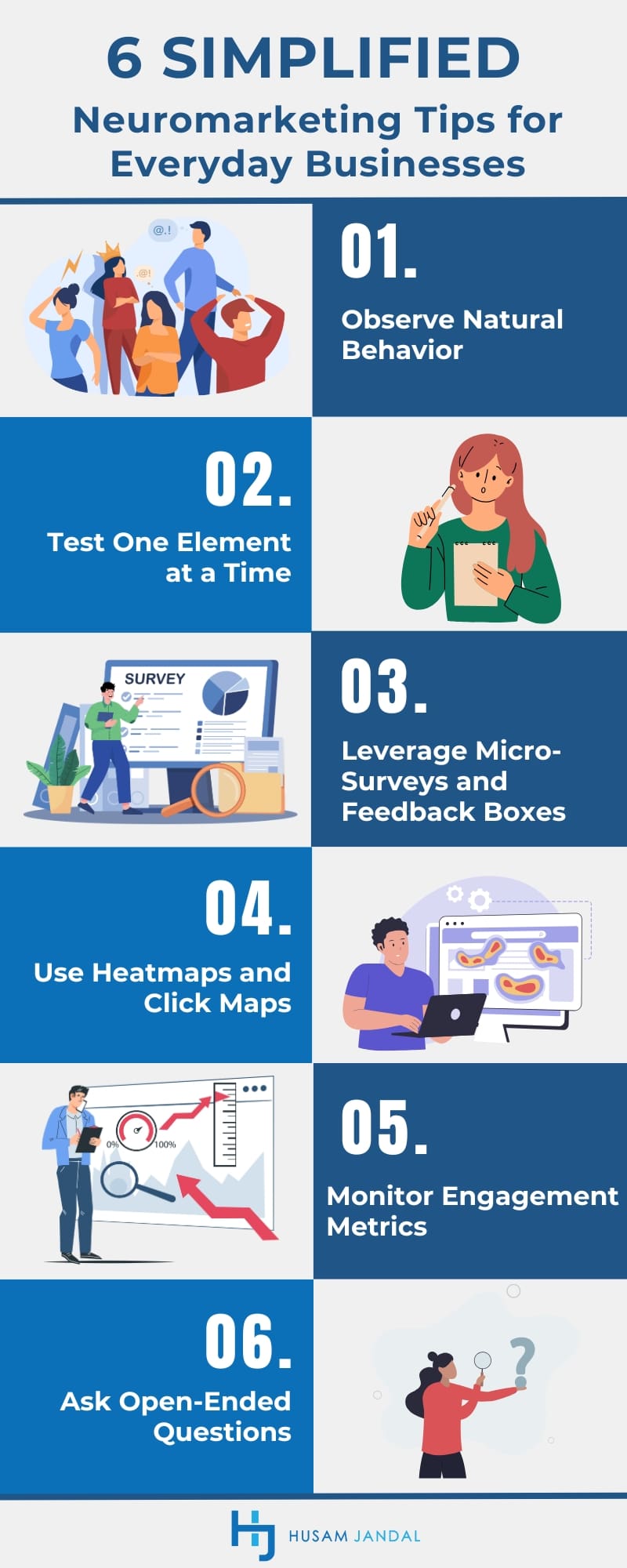 Which of these pitches resonates more with you:
Which of these pitches resonates more with you:
- “Automate your marketing processes.”
- “Put your business growth on autopilot and free yourself to focus on the big picture.”
If you’re like most people, the second option grabs your attention more. It’s specific, emotional, and paints a vivid picture of the benefit. That’s no accident. It’s a psychological principle in action, tapping into how we naturally process information.
In fact, 95 percent of purchasing decisions are subconscious, according to research from Harvard professor Gerald Zaltman. If your brand isn’t connecting with people in a real and visceral way, it’s going to flatline.
Emotional triggers, like the example above, are just one way psychology can transform your digital marketing. Below, I’ll explore common psychological tactics you can leverage ethically to build stronger customer relationships and drive lasting results.
Emotional Triggers
Emotional triggers are basically those little “buttons” in our minds that, when pressed, influence how we think and behave, often more powerfully than a straightforward sales pitch. Instead of focusing on product specs or discounts alone, you’re getting under the surface and connecting with what makes your audience tick on a personal, human level.
Why Emotional Triggers Matter
- Forge Deeper Connections: When you tap into emotion, you’re giving customers a reason to care beyond price or features. Research shows that emotionally engaged customers are more than twice as valuable to a brand compared to highly satisfied ones, per Harvard Business Review (HBR).
- Shape Purchase Decisions: Emotions can spur immediate action. For example, fear of missing out (FOMO) can turn a “maybe later” shopper into a “buy now” customer.
- Create Memorable Campaigns: As Maya Angelou said, “People will forget what you said, people will forget what you did, but people will never forget how you made them feel.” Emotional triggers help you stick in their minds long after they’ve scrolled past your content.
How to Identify and Use Emotional Triggers
- Know Your Audience: Start by researching what your ideal customers care about. Are they worried about saving time, feeling part of a community, or achieving a personal goal?
- Experiment with Messaging: Test different angles. Perhaps share a story that evokes hope, imagery that conveys comfort, or language that instills excitement.
- Keep It Authentic: Don’t force an emotion just because you know it “works.” If your message comes off as contrived or manipulative, you’ll lose trust fast.
Cognitive Biases
Cognitive biases are the mental shortcuts people use to make sense of the world. They’re snap judgments that often occur without a person even realizing it. By understanding these biases, you can nudge potential customers toward your offer without feeling pushy or insincere. They allow you to work with the human brain’s own quirks and tendencies, rather than fighting them.
Common Cognitive Biases Leveraged in Digital Marketing
- Anchoring Effect: The anchoring effect occurs when the first piece of information someone encounters influences how they perceive everything that follows. To leverage it, you might display a more expensive product first to make a subsequent lower-priced option feel like a bargain by comparison.
- Social Proof: Social proof refers to people’s tendency to rely on the actions and opinions of others when making decisions. Incorporating it could mean highlighting five-star reviews or user testimonials to convey that choosing your brand is a “safe bet.”
- Bandwagon Effect: The bandwagon effect is when individuals adopt a behavior or idea simply because many others do. For example, stating that thousands of customers already enjoy your service encourages newcomers to join in, assuming the crowd must be right.
- Scarcity and Urgency Bias: Scarcity and urgency biases drive people to act quickly to avoid missing out. Limited-time offers, low stock alerts, or countdown timers create a sense of pressure, prompting immediate conversions instead of waiting.
- Confirmation Bias: Confirmation bias makes people favor information that aligns with their existing beliefs. By aligning your messaging with your audience’s values or worldview, you reinforce their sense that they’re making the right choice.
- Loss Aversion: Loss aversion is the tendency to prefer avoiding losses over acquiring gains. Emphasize what customers stand to lose, like missing out on a sale or limited offer, rather than just the benefits they gain, making the offer feel more urgent and compelling.
- Authority Bias: Authority bias leads people to trust and follow recognized experts or credible figures. Featuring endorsements, credentials, and awards helps establish that you know your stuff, boosting customer confidence in your brand.
Why Cognitive Bias Matters
- Enhance Your Brand’s Appeal: By understanding the mental shortcuts guiding your audience, you can present information in a way that clicks instantly. For example, displaying a high-end option first can subtly elevate the perceived value of your more affordable offerings.
- Cut Through the Noise: In crowded digital spaces, leveraging cues that audiences trust, like showcasing the popularity of a product or featuring real customer stories, can give your brand’s message the spotlight it deserves. Instead of shouting louder, you’re aligning with the way people naturally decide what’s worth paying attention to.
- Streamline the Decision Process: Most customers want a smooth path to purchase, not a maze. By tapping into biases that reduce uncertainty, you help shoppers feel confident hitting “buy” without overthinking. It lets you guide them effortlessly toward choices they’ll feel good about later.
How to Leverage Cognitive Bias in Digital Marketing
- Spot the Relevant Bias: Identify which mental shortcuts match the behavior you want to inspire. Are you aiming to reduce buyer hesitation (try anchoring), or encourage trust (use social proof)?
- Test and Refine: Don’t assume one approach will work for everyone. Experiment with different biases on small segments of your audience to see what resonates best.
- Keep it Ethical: Recognize that biases can be powerful. Always aim to guide, not manipulate. You can use these insights to clarify choices for your customers, helping them reach decisions that feel both comfortable and beneficial.
Brand Storytelling Techniques
Your brand’s story is the “why” behind everything you do. It’s the values, personality, and narrative that make you worth listening to. By shaping a brand story that resonates at a human level, you transform your brand from a static vendor into a meaningful presence in your customers’ lives.
Why Brand Storytelling Works
- Forges a Human Connection: Facts and figures are fine, but relatable stories stick. When customers can see themselves in the struggles, hopes, and triumphs your narrative reveals, they care more about what you do and why you do it.
- Differentiates You in a Crowded Market: Your story helps you stand apart from competitors offering similar products. A brand that conveys its origins, mission, or the personal journey of its founders doesn’t just sell something. It sells an ethos that attracts people who share those values.
- Builds Trust and Loyalty: Real stories grounded in genuine experiences give people a reason to believe in you. Customers who trust your brand’s character and backstory are more likely to return, recommend you to others, and stand by you through market shifts.
How to Develop a Compelling Brand Narrative
Start with Authenticity: Don’t invent a backstory. If your brand began in a garage or with a single passionate idea, say so. Customers appreciate honesty and vulnerability more than polished perfection.
- Show Purpose, Not Just Product: Highlight how your offerings solve real problems or improve lives. Maybe you’re cutting waste from the supply chain, empowering artisans, or simplifying a painful buying process. Whatever your purpose, make it a central theme.
- Use a Relatable Character or Voice: Whether it’s your founder’s personal struggles or a fictional persona that embodies your customers, give your story a “hero” people can cheer for. Aim to inspire empathy or aspiration—something that resonates on a gut level.
- Keep the Narrative Consistent: From social posts to product descriptions, ensure your voice and tone reinforce the same big picture. Consistency across all channels makes your brand identity easy to understand and remember.
- Evolve as Your Brand Grows: A good story doesn’t stay frozen in time. Update it as your company learns lessons, overcomes challenges, or expands its mission. Show that you’re not static, that your brand continues to develop, just like your audience.
Audience Segmentation and Personalization
On the surface, segmentation might not seem like it has anything to do with psychology. After all, it’s a basic marketing process, perhaps one that happens in the background and is easy to forget about. But, here’s the thing: not every customer lands on your site with the same priorities, challenges, or motivations. Their mindsets are different. By categorizing your audience into distinct groups and personalizing your approach, you ensure your message feels hand-delivered rather than mass-mailed. Instead of talking at everyone, you’re having meaningful “conversations” with the people who matter most.
Why Segmentation and Personalization Matter
- Boosts Relevance: When your message reflects the recipient’s situation, it’s more likely to hit home. Matching product recommendations or even email subject lines to a customer’s past browsing habits can spark a “this is just for me” reaction.
- Reduces Noise: Broad messaging often fades into the background. By focusing on what specific groups care about, be it budget-friendly solutions, ethical sourcing, or cutting-edge technology, you cut through the clutter and capture real attention.
- Encourages Action: Personalized content feels like a well-timed nudge from someone who gets you. Whether it’s a discount on a product they’ve repeatedly viewed or content that aligns with a known interest, personalized touches guide customers toward the next logical step.
How to Apply Segmentation and Personalization Well
- Gather the Right Data: Study your analytics, survey customers, and track behaviors like purchase history or content engagement. The more relevant intel you have, the better you can fine-tune your targeting.
- Start Small and Grow: You don’t have to build intricate profiles overnight. Begin by segmenting at a high level, such as splitting new vs. returning customers, and then refine as you learn what truly resonates with each subgroup.
- Use Tools Wisely: Leverage a customer relationship management (CRM) platform or personalization software that allows you to tailor email campaigns, on-site recommendations, and ad targeting without manual guesswork. Technology helps you scale what used to feel impossible.
- Keep Testing and Adjusting: Preferences shift, markets evolve, and what worked last quarter might need tweaking now. Regularly review how each segment responds to your content, and don’t hesitate to swap strategies if engagement wanes.
Social Proof and Influence

Trust is a powerful currency in today’s digital landscape. When prospective customers see that others, such as industry experts, influencers, or everyday shoppers, have already embraced your brand, they’re more inclined to follow suit. Social proof turns unfamiliar names into reliable, recognizable players worth doing business with, while the right influencers can shape perceptions and guide purchasing decisions.
Why Social Proof and Influence Matters
- Accelerates Trust-Building: People naturally look to others for cues on what’s worthwhile. Showcasing satisfied customers, positive reviews, or well-known endorsers gives new visitors an instant reason to believe in you before they’ve even tried your product.
- Reduces Risk Perception: A glowing testimonial or a seal of approval from a figure your audience respects provides reassuring evidence that your offer isn’t a gamble. It’s like a friendly nudge that says, “Relax, this choice is safe.”
- Aligns with Audience Values: Influencers often bring their own niche communities and shared interests. Partnering with someone who already resonates with your audience connects you directly to people who value the same qualities, be it authenticity, innovation, or a sustainable approach.
How to Make Social Proof and Influence Work
- Feature Real Stories: Highlight genuine customer testimonials, interviews, or case studies. Specifics, like how much time they saved or the exact results they achieved, add weight and credibility.
- Use Recognizable Figures: Collaborate with influencers, experts, or respected organizations to lend authority. For instance, a nod from a well-known professional in your industry can shift perception from “unknown brand” to “trusted choice.”
- Show Quantity and Quality: Let numbers speak. A simple display of “1,200 five-star reviews” or “Over 50,000 happy customers” conveys reliability at a glance. Just be sure the proof is honest and verifiable.
- Keep it Current: Regularly update testimonials and influencer partnerships. Fresh stories assure newcomers that people like them are still finding value in your brand today, not just two years ago.
Neuromarketing
Neuromarketing explores how the human brain reacts to branding, ads, and product experiences on a subconscious level. Rather than relying solely on what customers say, it looks at what their brains do through methods like eye-tracking studies, EEG scans, or even facial-expression analysis. By understanding these automatic responses, you gain insights that can help refine your messaging, design, and overall brand experience.
Why Neuromarketing Matters
- Reveals Genuine Preferences: Traditional surveys can be misleading when people don’t know or won’t admit what influences them. Neuromarketing digs beneath the surface, uncovering hidden cues that truly resonate or turn customers off.
- Informs Subtle Design Choices: Sometimes a tweak as simple as changing a background color or repositioning a call-to-action button can shift engagement levels. Neuromarketing insights help you make data-backed adjustments that might otherwise feel like guesswork.
- Guides Emotional Connection: By detecting the emotional impact of your content on a physiological level, you can fine-tune messaging to evoke the right feelings. Whether it’s excitement, comfort, or aspiration, you’re crafting an experience that matches the mood you want to create.
Common Neuromarketing Techniques
- Eye-Tracking: By following where a viewer’s gaze lands and how long it lingers, you discover which elements of your ad or webpage command the most attention. For instance, if people skip over your call-to-action button, it may need a stronger color contrast or more prominent placement.
- Facial Coding: Using subtle cues like micro-expressions—those brief, involuntary facial movements—you can gauge emotional reactions to your messaging. If a video sparks more smiles at a certain moment, you know that segment resonated positively.
- EEG (Electroencephalography) Scans: EEG technology measures brain waves to see which parts of the brain “light up” when customers view your content. This can help you understand if your content triggers feelings of excitement, engagement, or even stress, guiding you on what to tweak.
- Galvanic Skin Response (GSR): When people become emotionally stimulated, their sweat gland activity changes—even if just slightly. Monitoring this response can show which parts of a webpage or ad provoke emotional intensity, whether it’s delight at a surprise discount or anxiety from complex navigation.
- Implicit Association Tests: These tests measure how quickly people link certain concepts (like “your brand”) to positive or negative terms. A fast positive association indicates that your messaging aligns smoothly with how customers want to feel about your brand, while slower responses suggest there’s room for improvement.
- Neuro-Driven A/B Testing: Instead of guessing what works, some companies combine neuromarketing data with A/B testing. They present two versions of a page or ad and track physiological responses to see which one consistently evokes the most positive engagement.
Simplified Neuromarketing Techniques for Everyday Businesses

While neuromarketing may sound high-tech and out of reach, you can still use its core principles without fancy equipment. Think of it this way: neuromarketing is about understanding natural, human responses to your marketing—no lab coats required. Here are some scaled-down strategies that anyone can implement.
- Observe Natural Behavior: Instead of eye-tracking software, watch how users navigate your website via analytics tools like Google Analytics or Hotjar. Track which pages visitors spend the most time on, which sections they scroll past, and where they linger. This gives you a rough, low-cost version of “where their eyes are going.”
- Test One Element at a Time: Instead of wiring up testers to an EEG, run simple A/B tests. Change just one element, like the headline color, the product image, or the button text, and see which version gets more clicks or leads. You’re essentially measuring a subconscious preference by comparing what people do, not what they say.
- Leverage Micro-Surveys and Feedback Boxes: While not as scientific as a skin-response test, a quick pop-up survey can hint at emotional reactions. For instance, if many respondents say they feel “confused” or “overwhelmed” at checkout, that’s a red flag that something’s triggering a negative response. On the flip side, a high number of “excited” or “inspired” responses suggest you’re on the right track.
- Use Heatmaps and Click Maps: Tools like Crazy Egg or Hotjar generate visual maps showing where visitors hover and click most. If your “Buy Now” button is in a cold spot, consider moving it. These patterns indirectly reveal attention, interest, and even frustration—key emotional signals without the need for lab equipment.
- Monitor Engagement Metrics: Sometimes simple metrics like “time on page,” “scroll depth,” or “return visits” can serve as proxies for engagement. If people stay longer or keep coming back, it suggests you’re meeting an emotional or informational need. That steady interest is a good sign your content resonates on a deeper level than just a quick skim.
- Ask Open-Ended Questions: While it’s not neuromarketing in the strict sense, listening to the language your customers use in open-ended responses can reveal emotional drivers. Words like “relieved,” “excited,” or “reassured” show what feelings are bubbling under the surface. Adjust your messaging accordingly to amplify the positive emotions and ease the negative ones.
How to Apply Neuromarketing Practices
- Start Small: Full-scale neuromarketing studies can be pricey and complex, but you don’t need a lab to apply the principles. Begin with simpler, low-cost tools like user testing and heatmaps to see where eyes linger or where friction arises.
- Test Before a Big Launch: Use neuromarketing insights to refine packaging, landing pages, or ad creatives before going live. A small pilot test can save you from pouring big budgets into a direction that doesn’t emotionally connect.
- Keep Ethics in Check: While it’s tempting to exploit subconscious triggers, always use this knowledge responsibly. The goal is to enhance user experience and relevance, not to manipulate or deceive.
Ethical Considerations
When you start using psychological insights to influence customers, keep ethics top of mind. Customers appreciate when you anticipate their needs or present solutions in a friendly, relatable way, but they’ll quickly lose trust if they feel tricked or pressured.
Why Ethics Matter
- Builds Enduring Trust: Gaining a quick sale by misleading or overhyping can damage your reputation once customers realize what’s happened. Long-term loyalty comes from honesty and transparency.
- Protects Your Brand Identity: Your brand should stand for something positive in people’s minds. If your marketing feels manipulative, that undercuts your mission and makes it harder to maintain credibility in the long run.
- Meets Customer Expectations: Today’s consumers are savvier than ever. They value brands that respect their intelligence and autonomy, and they’re quick to call out shady tactics on social media or review platforms.
How to Keep It Honest
- Transparent Claims: Don’t promise life-changing miracles if you can only deliver incremental improvements. Sticking to verifiable facts and reasonable claims shows you respect your audience’s judgment.
- Respect Boundaries: Don’t rely on fear or shame to pressure people into buying. Tactics that cause anxiety or create an artificial sense of inadequacy leave a bad taste and can backfire if customers feel manipulated.
- Use Positive Reinforcement: Focus on the genuine benefits and the positive outcomes your products or services provide. Encouraging customers by highlighting what they’ll gain, not what they’ll miss, is more uplifting and ethical.
- Engage in Open Dialogue: If you’re collecting data or tracking user behavior, be upfront about it. Give visitors clear options to control their experience, such as a way to opt in or out of personalized recommendations.
- Regularly Review Your Practices: What felt acceptable last year might feel off today. Keep revisiting your marketing strategies, making sure they still align with both legal guidelines and evolving social norms.
Get Help Developing a Comprehensive Digital Marketing Strategy
This guide has offered a glimpse into the psychological principles that fuel successful marketing campaigns, showing how understanding your audience’s emotions, biases, and behaviors can transform your strategy. But, applying these insights effectively requires a tailored approach. That’s where expert guidance makes all the difference.
As a seasoned digital marketing consultant with a business background, I help growth-focused companies implement the people, processes, and strategies needed to maximize easy wins using ethical psychological techniques while building lasting relationships. Curious about how this could work for your business? Let’s chat. Contact me for a complimentary consultation.
FAQs on the Psychology Behind Marketing
Which principles of marketing psychology can strengthen emotional resonance in my campaigns?
Principles like using emotional triggers, framing messages in relatable terms, and leveraging social proof can strengthen your campaign’s impact. Emotional triggers—such as hope, nostalgia, or belonging—evoke feelings that stick in the mind. Framing your offer in terms of positive outcomes rather than just features helps customers envision how it fits their lives. Showcasing testimonials, case studies, or endorsements taps into social proof, reassuring them that others find value in what you provide. Together, these psychological approaches create a sense of familiarity, trust, and comfort. By focusing on emotional resonance, you encourage viewers to remember your brand and feel an instinctive pull toward your products or services, rather than merely considering them logically.
What cognitive biases affect consumer choices, and how can I adapt my messaging to match them?
Common cognitive biases include the anchoring effect, social proof, and confirmation bias. The anchoring effect makes people latch onto initial information—so start strong with attractive offers or value comparisons. Social proof reassures customers that others approve, so highlight positive reviews or success stories. Confirmation bias means people favor information that aligns with their beliefs—so they tailor messaging to what they already value. By acknowledging these biases, you refine your communication. Whether emphasizing real customer success, setting helpful price anchors, or reinforcing existing preferences, you create a smoother decision-making path. This approach respects natural thought patterns, increasing the likelihood that your audience feels confident and comfortable choosing your brand.
How do audience segmentation and authenticity lead to more effective marketing campaigns?
Segmenting your audience ensures you’re not shouting into a crowd but speaking directly to individuals who share specific interests or pain points. This allows you to deliver messages that match their context. Authenticity means showing genuine understanding and honesty rather than flashy, one-size-fits-all claims. When combined, segmentation and authenticity create campaigns that feel personal and sincere. It’s like having a conversation rather than giving a lecture. Customers recognize when a message resonates with their unique needs and concerns. As a result, they trust your intentions, engage more willingly, and respond more positively. Ultimately, this targeted, heartfelt approach turns generic promotions into meaningful dialogues that truly connect.
Can insights from neuromarketing and social proof drive sustainable growth marketing initiatives?
Yes. Neuromarketing helps you understand subtle responses—like which visuals, colors, or headlines hold attention best—so you can refine each aspect of your campaign. Social proof builds trust by showcasing customer endorsements, ratings, or influencer partnerships. Together, these insights guide you to create more compelling, emotionally attuned messaging that feels credible and inspiring. When customers consistently respond well, you enjoy steady growth rather than one-time spikes. By merging what resonates subconsciously with clear signals of approval from peers, you meet both psychological and logical expectations. The result? Repeat business, stronger brand loyalty, and more predictable long-term performance. It’s a way to grow sustainably, step by step, guided by what truly speaks to your audience.
What practical steps can improve my marketing skills and foster deeper trust with customers?
Begin by listening—gather feedback through surveys, interviews, or direct conversations. Use analytics tools to spot patterns and better understand what customers respond to. Continuously refine your messaging: test small changes in headlines, images, or calls-to-action, and measure the results. Study basic psychological principles and consider how they apply to your unique market. Leverage tools like heatmaps or user recordings to see where users focus their attention. Above all, be transparent about pricing, policies, and product benefits while highlighting real success stories. Each small improvement builds credibility over time. As you adapt to feedback and demonstrate genuine care, you nurture trust—ultimately converting improved marketing skills into loyal, enthusiastic relationships with your audience.





































































